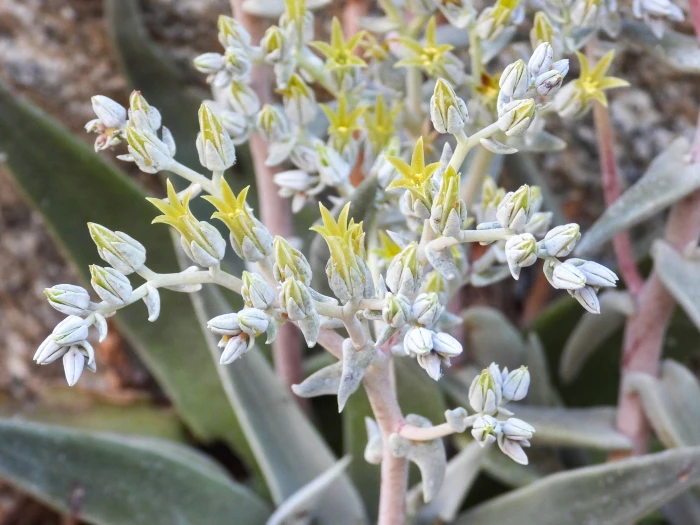Abrams’ Liveforever
(Dudleya abramsii)
Abrams’ Liveforever (Dudleya abramsii)
/
/

James M. Maley
CC BY 4.0
Image By:
James M. Maley
Recorded By:
Copyright:
CC BY 4.0
Copyright Notice:
Photo by: James M. Maley | License Type: CC BY 4.0 | License URL: http://creativecommons.org/licenses/by/4.0/ | Rights Holder: James M. Maley | Publisher: iNaturalist | Date Created: 2022-04-27T09:07:46-07:00 |

























Estimated Native Range
Climate Requirements for Deer Park, New York
| This Plant | Your Site | Plant Suitability for Your Location | ||
|---|---|---|---|---|
| • Precipitation | 4" - 35" | 42" | Aquatic | Aquatic |
| • High Temp. | 74°F - 102°F | 82°F | Your summer temperatures are normal for this plant. | Excellent |
| • Low Temp. | 21°F - 41°F | 24°F | Your winter temperatures are normal for this plant | Excellent |
This plant may not grow well at your location - your precipitation is too high.
Summary
Dudleya abramsii, commonly known as Abrams’ liveforever, is a succulent plant native to the rocky outcrops and cliffs of coastal California and northern Baja California. It is a small, slow-growing perennial that forms rosettes of fleshy leaves, which can vary in color from green to red-tinged, particularly under stress or with age. Dudleya abramsii typically produces an inflorescence bearing up to 15 bright yellow flowers in the spring and early summer, which are attractive to pollinators such as bees and hummingbirds. The plant can reach up to 12 inches (30 cm) in height and width when in flower.
Abrams’ liveforever is valued in cultivation for its drought tolerance and its striking form, which makes it a popular choice for rock gardens, succulent collections, and as a container plant. It requires minimal water once established, well-draining soil, and thrives in full sun to partial shade. While generally low-maintenance, it can be susceptible to root rot if overwatered or planted in poorly draining soils. In addition to its horticultural appeal, Dudleya abramsii plays a role in its native ecosystem by providing nectar for local pollinators. Due to its conservation status, it is important to source plants from reputable nurseries that do not collect from the wild.CC BY-SA 4.0
Abrams’ liveforever is valued in cultivation for its drought tolerance and its striking form, which makes it a popular choice for rock gardens, succulent collections, and as a container plant. It requires minimal water once established, well-draining soil, and thrives in full sun to partial shade. While generally low-maintenance, it can be susceptible to root rot if overwatered or planted in poorly draining soils. In addition to its horticultural appeal, Dudleya abramsii plays a role in its native ecosystem by providing nectar for local pollinators. Due to its conservation status, it is important to source plants from reputable nurseries that do not collect from the wild.CC BY-SA 4.0
Plant Description
- Plant Type: Succulent
- Height: 1.5-2 feet
- Width: 1-1.5 feet
- Growth Rate: Slow
- Flower Color: Red, White, Yellow
- Flowering Season: Spring, Summer
- Leaf Retention: Evergreen
Growth Requirements
- Sun: Full Sun, Part Shade
- Water: Low, Medium
- Drainage: Fast, Medium
Common Uses
Border Plant, Drought Tolerant, Low Maintenance, Rock Garden
Natural Habitat
Rocky outcrops and cliffs of coastal California and northern Baja California
Other Names
Common Names: Rose Dudleya, San Gabriel Dudleya
Scientific Names: Dudleya abramsii, Dudleya costafolia, Dudleya cymosa subsp. costafolia
GBIF Accepted Name: Dudleya abramsii